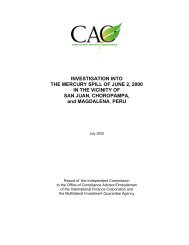A Guide to Designing and Implementing Grievance Mechanisms for ...
A Guide to Designing and Implementing Grievance Mechanisms for ...
A Guide to Designing and Implementing Grievance Mechanisms for ...
You also want an ePaper? Increase the reach of your titles
YUMPU automatically turns print PDFs into web optimized ePapers that Google loves.
Incorporate a variety of grievance resolution approaches. To accommodate differences in<br />
personal <strong>and</strong> cultural preferences, the grievance mechanism should offer a variety of grievance<br />
resolution approaches—not just a single grievance procedure. The complainant should have<br />
influence over which approach <strong>to</strong> select. Some complaints may be managed in an in<strong>for</strong>mal way<br />
solely by those directly involved, such as a company representative <strong>and</strong> the complainant.<br />
Others may rely on more <strong>for</strong>mal independent redress, such as arbitration using a neutral third<br />
party. Some mechanisms may rely on an interest-based approach, such as responding <strong>to</strong> the<br />
stated legitimate <strong>and</strong> perceived needs of the complainant. Others may rely on a rights-based<br />
approach, based on legal, contractual, or other rights. Where possible, local, cus<strong>to</strong>mary ways<br />
of grievance resolution should be evaluated <strong>and</strong> incorporated in<strong>to</strong> the system.<br />
The grievance mechanism should offer a variety of approaches,<br />
not just a single grievance procedure. The complainant should<br />
have influence over which approach <strong>to</strong> select.<br />
Identify a central point <strong>for</strong> coordination. A well-publicized <strong>and</strong> consistently staffed position,<br />
held by an individual or team, should be maintained. This central coordina<strong>to</strong>r facilitates the<br />
development <strong>and</strong> implementation of the grievance mechanism, administers some of its resources,<br />
moni<strong>to</strong>rs internal <strong>and</strong> external good practice, ensures coordination among access points,<br />
<strong>and</strong> makes certain that the system is responsive <strong>to</strong> the in<strong>for</strong>mation it manages.<br />
Maintain <strong>and</strong> publicize multiple access points. Exp<strong>and</strong>ing access beyond those individuals<br />
who have the primary responsibility <strong>to</strong> receive grievances can significantly reduce barriers <strong>to</strong><br />
entering the system <strong>and</strong> encourage community members <strong>to</strong> address problems early <strong>and</strong><br />
constructively. Individuals serving as access points are most effective if they are trustworthy,<br />
trained, knowledgeable, <strong>and</strong> approachable regardless of the ethnicity, gender, or religion of<br />
the complainant.<br />
Report back <strong>to</strong> the community. The company should provide regular feedback <strong>to</strong> relevant<br />
stakeholders <strong>to</strong> clarify expectations about what the mechanism does <strong>and</strong> does not do;<br />
<strong>to</strong> encourage people <strong>to</strong> use the mechanism; <strong>to</strong> present results; <strong>and</strong> <strong>to</strong> gather feedback <strong>to</strong><br />
improve the grievance system. In<strong>for</strong>mation reported back might include types of cases <strong>and</strong><br />
how they were resolved, <strong>and</strong> the way the grievance has influenced company policies,<br />
procedures, operations, <strong>and</strong> the grievance mechanism itself.<br />
Use a grievance log <strong>to</strong> moni<strong>to</strong>r cases <strong>and</strong> improve the organization. In addition <strong>to</strong><br />
resolving individual or community disputes, the grievance mechanism is an opportunity <strong>to</strong><br />
promote improvements in the company. A grievance log (or register) can be used <strong>to</strong> analyze<br />
in<strong>for</strong>mation about grievance <strong>and</strong> conflict trends, community issues, <strong>and</strong> project operations <strong>to</strong><br />
anticipate the kinds of conflicts they might expect in the future, both <strong>to</strong> ensure that the<br />
grievance mechanism is set up <strong>to</strong> h<strong>and</strong>le such issues <strong>and</strong> <strong>to</strong> propose organizational or<br />
operational changes. Sometimes, enacting policies or other types of structural change can<br />
resolve grievances around a common issue, rather than continuing <strong>to</strong> settle individual<br />
complaints on a case-by-case basis.<br />
Evaluate <strong>and</strong> improve the system. The company should periodically conduct an internal<br />
assessment of the grievance mechanism <strong>to</strong> evaluate <strong>and</strong> improve its effectiveness. Important<br />
elements of evaluation include: general awareness of the mechanism; whether it is used <strong>and</strong> by<br />
whom; the types of issues addressed; the ability of the mechanism <strong>to</strong> resolve conflicts early <strong>and</strong><br />
3





